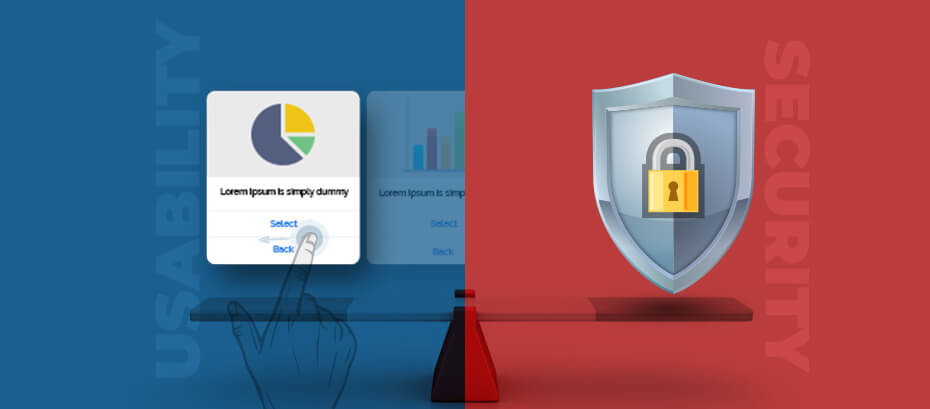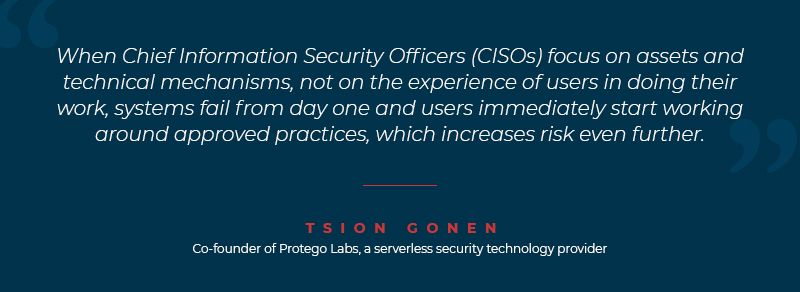
The scale of data breaches reported this year have been staggering and if you think Facebook was the biggest one, you might be wrong. Therefore, the importance of security cannot be overlooked by an enterprise application development company. At the same time, developers need to make sure that security does not get in the way of usability and hinder app performance.
Does security really impedes usability?
Well, the inherent conflict between usability and security does flourish at the workplace with users longing for ease of use while system’s owners desiring comprehensive security. As security is mostly added at the end of development, it limits access to applications and also obstructs usability.
Although balancing security with usability might seem like an endless pursuit, still finding a balance between these two important factors is necessary and is a unique challenge every business is facing today. However, if you start thinking about usability and security together and consider having security and usability specialists in the development team, you might be able to find a balance in the security-usability spectrum.
Want to build a secure enterprise app that empowers your employees?
Collaborate with our enterprise app development team today!
How to make usability and security go hand-in-hand?
Usability, according to the definition in the ISO 9421-11, is “the extent to which a product can be used by specified users to achieve specified goals with effectiveness, efficiency, and satisfaction in a specified context of use.”
This implies that usability is not just about ease of use but also about user satisfaction which can be achieved through engaging content, aesthetically-pleasing design and effective functionality.

Based on our vast experience as a leading enterprise app development company, we have compiled the below pointers to help you find the right balance between security and usability.
Security by design approach
Our team of software development experts believes that “security by design” is the best approach to security. This approach enables them to avoid the costly attempt of adding security at the end of development of the enterprise app.
This proactive approach of co-opting security during the development process is analogous to building a door with built-in a tamper-proof deadlock while adding security layers at a later stage is like adding multiple locks after the installation of door to maintain the same strength.
Focus on simplicity
Simpler apps with a minimalist design are not only easier to understand for users but are also easier to secure. Simpler code has lesser vulnerabilities and it also lowers the possibilities of users doing anything that compromises the security of your app.
You should consider simplifying features and services of your enterprise apps and putting in the minimal security necessary to detect and stop the actions of users with potential security implications.
Implement biometric authentication
Incorporating biometric-based security offers quite a few advantages to your enterprise app without affecting usability. Biometrics can replace the need for remembering passwords and managing token-based systems altogether while eliminating the risk of data breach through stolen passwords.
You can also add multiple layers of security to your enterprise app with biometric-based multi-factor authentication i.e., add iris or face scan to fingerprint to provide strong authentication.
Engage the users of your enterprise apps
Security is not solely a technological challenge; so bring in people of your organization in the security equation and consider workforce training and awareness programs so that they can apply what they are taught. Engaging them in the process of data protection would not only help them avoid risky behavior but also ensure there are lots more eyes to monitor if anything is amiss.
Making your employees active participants in the security awareness initiative would prevent your enterprise security provisions from getting compromised to a greater extent.
Provide different data access permissions for users
Not all users of your enterprise are the same; therefore, our software development experts recommend giving most users limited access to app features you in order to keep your enterprise app and data more secure.
Our enterprise app development team closely works with security as well as UX experts to address the core problems of user experience without compromising security. They also include some in-product notifications in order to remind users the security preferences that they had previously chosen to prevent potential security risks, without affecting usability.
Test to determine security and usability balance
Testing is an integral part of our enterprise app development; our developers observe users using their app features to test them for potential security as well as usability issues.
Such observations have often helped them understand that something that appears quite obvious to them may not be that obvious for the users. And also making an application unnecessarily complex by adding security layers could lead to poor user experience.
Integrate security into your culture
As already discussed, including your workforce who will be engaging with your enterprise app in the security program will help in creating the security environment that you want in your enterprise.
Although heightened security in your app might decrease the ease-of-use in some areas, if people understand how to work through these challenges then it would eliminate workplace frustrations.
Therefore, consider security of your enterprise data as a business problem and not as an IT-problem in order to make your security measures successful in the long run.
Usability vs. Security: The ongoing battle?
The battle between usability and security is often observed throughout the workplaces, such as critically strong passwords written down on sticky notes, files shared through online services not sanctioned by IT departments and much more.
Strengthening security measures typically undermines usability, no doubt, but there can be ways to address this conundrum. And the best and worst part is there are no set answers!
So, what’s your strategy to balance these two concepts? Please be the first to leave your comment. Get in touch with us to develop a highly secure and intuitive app.



